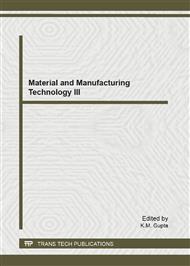[1]
Xiaobing Chen, Identify Failure Signatures for Different Electrostatic Discharge Models, Shanghai: Shanghai Jiaotong University, 2006, 38.
Google Scholar
[2]
ADI Reliability Handbook, Analog Devices, Inc., 2000, 16.
Google Scholar
[3]
D.C. Wunsch, and RR Bell, Determination Of Threshold Voltage Levels Of Semiconductor Diodes And Transistors Due To Pulsed Voltages, IEEE Trans. on Nuclear Science, 1968, 15, 244-259.
DOI: 10.1109/tns.1968.4325054
Google Scholar
[4]
V.I. Arkihpov, E. R Astvatsaturyan, V.I. Godovosyn, and A.I. Rudenko, International Journal of Electronics, 1983, 55, 395.
Google Scholar
[5]
V. M. Dwyer, A. J. Franklin, and D.S. Campbell, Thermal Failure in Semiconductor Devices, Solid State, 1989, 553-560.
DOI: 10.1016/0038-1101(90)90239-b
Google Scholar
[6]
T.S. Speakman, A Model for Failure of Bipolar Silicon Integrated Circuits Subjected to Electrostatic Discharge, 12th Annual Proceedings, Reliability Physics, 1974, 60-69.
DOI: 10.1109/irps.1974.362628
Google Scholar
[7]
D. M. Tasca, Pulse Power Failure Modes in Semiconductors, IEEE Trans. on Nuclear Science, 1970, 17, 346-372.
DOI: 10.1109/tns.1970.4325819
Google Scholar
[8]
Ash, Semiconductor Junction Non-linear Failure Power Thresholds: Wunsch-Bell Revisited, EOS/ESD Symposium, 1983, 122-127.
Google Scholar
[9]
W.D. Brown, Semiconductor Device Degradation by High Amplitude Current Pulses, IEEE Trans. On Nuclear Science, 1972, 19.
DOI: 10.1109/tns.1972.4326810
Google Scholar
[10]
D. R Alexander, and E.W. Enlow, Predicting Lower Bounds on Failure Power Distributions of Silicon NPN Transistors, IEEE Trans. On Nuclear Science, 1981, 28.
DOI: 10.1109/tns.1981.4335718
Google Scholar
[11]
E.N. Enlow, Determining an Emitter-Base Failure Threshold Density of NPN Transistors, EOS/ESD Symposium, (1981).
Google Scholar
[12]
D. Pierce and R. Mason, A Probabilistic Estimator for Bounding Transistor Emitter-Base Junction Transient-Induced Failures, EOS/ESD Symposium, 1982, 82-90.
Google Scholar
[13]
Steven H. Voldman, Electrostatic Discharge (ESD) and Failure Analysis: Models, Methodologies and Mechanisms, Proceedings of 9th IPFA, 2002, 57-63.
Google Scholar


